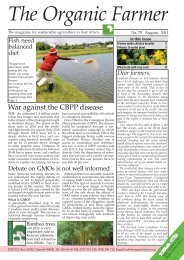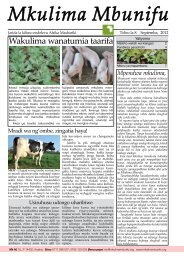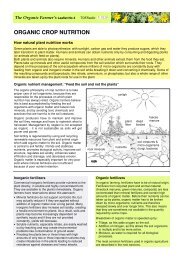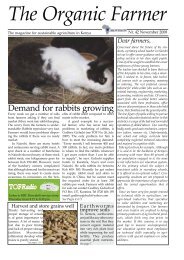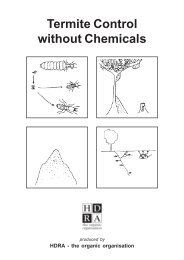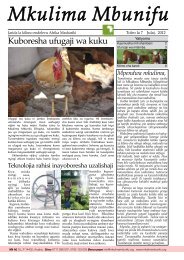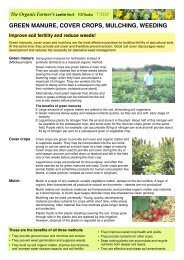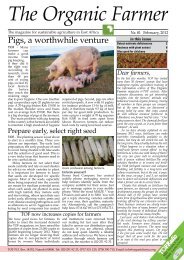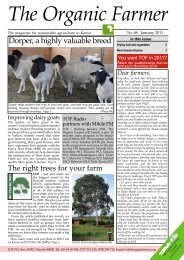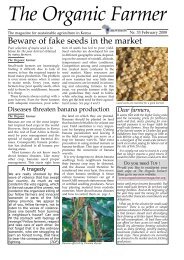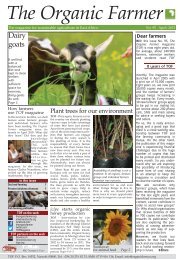The Neem Tree - Infonet-Biovision
The Neem Tree - Infonet-Biovision
The Neem Tree - Infonet-Biovision
You also want an ePaper? Increase the reach of your titles
YUMPU automatically turns print PDFs into web optimized ePapers that Google loves.
<strong>The</strong> <strong>Neem</strong> <strong>Tree</strong>produced byHDRA - the organic organisation
<strong>The</strong> <strong>Neem</strong> <strong>Tree</strong>What is neem?<strong>The</strong> neem tree (Azadirachta indica) is native to tropical South East Asia. It isfast growing, can survive drought and poor soil and keeps its leaves all yearround. It is a tall tree, up to 30 metres high, with leafy spreading branches.Many white flowers which smell of honey appear for the first time when the treeis 2 to 3 years old, and the tree bears fruit after 3 to 5 years. <strong>The</strong> ripe fruit areabout 2 centimetres (cm) long and oval shaped. Inside the fruit there is a lightcolouredseed about 1.5 cm long.How does neem grow?Rainfall and altitude<strong>Neem</strong> trees can be grown in areas which have between 400 millimetres (mm)and 1500mm of rain each year. It performs best at an altitude of less than1,500 metres.Temperature<strong>Neem</strong> trees will survive very hot temperatures, up to 44°C and as low as 4°C.Some people report neem trees surviving light frost.<strong>The</strong> seeds of neem do not live long and are usually planted as soon as possibleafter the fruit ripens and usually within three months. To help the seeds livelonger the fruit pulp should be removed by hand and the seeds dried in theshade to a level of 15 to 20% moisture content. If the seeds have been properlyair dried they should survive for up to twelve months in a refrigerator at 4°C.page 1HDRA - the organic organisation
<strong>The</strong> <strong>Neem</strong> <strong>Tree</strong><strong>The</strong> uses of neem<strong>The</strong>re are many different ways to use the extracts of the neem tree. Some ofthe most common methods are described in this section.<strong>Neem</strong> leaves for grain storageWhen neem is used in grain storage, pests can be kept away from the grain fora whole year; but if the grain is already infected with pests the protection willnot work.Method one1. Place a 1.5 cm layer of fresh neem leaves, is placed in the bottom of astorage container.2. Place a layer of sun dried grain (up to 30cm) is placed on top of thisfollowed by another layer of neem leaves.<strong>The</strong>se layers can be repeated until the container is full, finishing with a goodlayer of leaves.neem leavesgrainA grain container showing how neem leaves are applied between thelayers of grainpage 3HDRA - the organic organisation
<strong>The</strong> <strong>Neem</strong> <strong>Tree</strong>Method two1. Dry neem leaves in the sun so that the leaves stay green.2. Grind them into a powder.3. Mix the powder with clay and water.4. Plaster the inside walls of the storage container with themixture and allow to dry.5. Place a layer of neem leaves, which have been dried in theshade, on the bottom of the container.6. Fill the container with grain.7. Place a layer of dried neem leaves on top and closethe storage container.Method threeIf grain is being stored in sacks, neem leaf powder can be mixed directly withthe grain. Mix 1 or 2 kilograms (kg) of powder to 100 kg of grain.HDRA - the organic organisation page 4
<strong>The</strong> <strong>Neem</strong> <strong>Tree</strong>Crushed neemPreparing crushed neem seed1. <strong>The</strong> ripe fruit pulp should be removed from the seed as soon as possibleafter harvest, otherwise the seeds may become covered in mould. In someareas birds or fruit bats eat the pulp if the seeds are left outside anduncovered.2. <strong>The</strong> seeds should then be laid out in a thin layer in the sun to dry outfor a few days.3. <strong>The</strong> dried seeds should be stored incontainers with plenty of air tostop mould growing, such as basketsor sacks.4. <strong>The</strong> shells have to be removed usingstones or a big mortar. <strong>The</strong> looseshells can then be removed bywinnowing in the same way aswith cereals.5. <strong>The</strong> kernels are then ground in a millor in a mortar.page 5HDRA - the organic organisation
<strong>The</strong> <strong>Neem</strong> <strong>Tree</strong>Crushed neem seed to control stem borers on young plants1. A small amount of crushed neem seed powder should be mixed with thesame amount of dry clay or sawdust.2. <strong>The</strong> mixture is sprinkled over young plants or placed in the funnel of youngmaize and sorghum plants.3. Rain will gradually dissolve the active chemicals in the neem seed.4. This treatment may need to be repeated every 8 to 10 days until theplants flower.<strong>Neem</strong> powder is sprinkled in the funnel of young maize plantsHDRA - the organic organisation page 6
<strong>The</strong> <strong>Neem</strong> <strong>Tree</strong><strong>Neem</strong> oil from neem seedYou should be able to extract 100 to 150 milligrams of oil for every 1 kilogram ofneem seed.Extracting neem oil1. To press neem oil by hand, the kernels ofthe neem seed should be crushed in a millor pound in a mortar.2. Add a small amount of water until themixture forms a firm paste that can bekneaded.3. Knead the paste until oil drops form onthe surface.4. Press firmly to extract the oil.5. <strong>The</strong> kneading and pressing should becontinued in turn until the maximum amountof oil is removed. (<strong>The</strong> oil content of theseed kernel is about 45%).In some areas there are traditional ways of removing oil from other seeds suchas sesame or groundnut. It is a good idea to try these methods with neem.Heating the oil will not affect the ability of neem to control insects.page 7HDRA - the organic organisation
<strong>The</strong> <strong>Neem</strong> <strong>Tree</strong>Controlling Bruchid beetles in stored beans with neem oil<strong>Neem</strong> oil is used to control Bruchid beetles which are small beetles whoselarvae eat into stored beans and other legumes.Mix 2 to 3ml of neem oil for every 1kg of beans or seeds before storing.<strong>The</strong> oil has a bitter taste but it is not reported to change the taste of storedbeans for humans to eat.Cowpea BruchidGroundnut BruchidControl of soil-borne pests<strong>The</strong> neem cake which is left after the oil is extracted from the seed, is alsouseful for controlling several pests which live in the soil, particularly nematodes.HDRA - the organic organisation page 8
<strong>The</strong> <strong>Neem</strong> <strong>Tree</strong><strong>Neem</strong> waterPreparing neem water1. Grind 500 grams (g) of neem seed kernels in a mill or pound in a mortar.2. Mix crushed neem seed with 10 litres of water. It is necessary to use a lotof water because the active ingredients do not dissolve easily. Stir themixture well.3. Leave to stand for at least 5 hours in a shady area.4. Spray the neem water directly onto vegetables using a sprayer orstraw brush.5. Once applied the effect of the neem lasts for 3 to 6 days.<strong>Neem</strong> water can be stored and will remain effective for 3 to 6 days if it is kept inthe dark.If crops have to be watered, water should go directly on the soil because waterrunning over the leaves of sprayed plants may wash off the neem water extract.It has been estimated that 20 to 30kg of neem seed (an average yield from 2trees), prepared as neem water can treat one hectare of crop.page 9HDRA - the organic organisation
<strong>The</strong> <strong>Neem</strong> <strong>Tree</strong>What pests can neem extract be used against?<strong>Neem</strong> extracts are better at controlling some pests than others. Cold pressedneem oil and seed cake can both be used for pest control. <strong>The</strong> leaves can alsobe used to control pests, but there is less of the useful chemicals than inthe seed.Good control<strong>Neem</strong> extract is usually most effective against beetle larvae, butterfly and mothcaterpillars as their development into actual beetles is impaired. Examples ofthese are Mexican bean beetle larvae, Colorado potato beetle larvae anddiamondback moth.<strong>Neem</strong> is very effective against grasshoppers, leaf miners and leaf hoppers, forexample variegated grasshoppers, green rice leafhopper and cotton jassid. Whenneem is taken up by the plant it will usually affect leaf hoppers and plant hoppersbecause they feed from the inner part of the plant which carries the azadirachtinaround inside the plant. Grasshoppers will stop eating almost immediately afterneem extract is applied but caterpillars may not stop eating for 2 or 3 days.Controlling locusts with neem is very effective. neem spray makes them slow,flightless and solitary as opposed to a swarming mass.<strong>Neem</strong> provides good control for various flies. <strong>The</strong> horn fly breeds in animaldung. If neem is fed to animals the flies are repelled by the smell and taste ofneem in the dung. <strong>The</strong> same is true for fruit flies. <strong>Neem</strong> water sprayed underfruit trees, where fruit flies usually breed and larvae develop, stops the growth ofthe larvae into flies.page 11HDRA - the organic organisation
<strong>The</strong> <strong>Neem</strong> <strong>Tree</strong>Why use neem for pest control?Pests are often controlled with man made chemicals which have manyharmful effects.• Artificial chemicals kill useful insects which eat crop pests.• Artificial chemicals can be very bad for the health of people who use themand people who eat food with small amounts of chemicals in the skin, theleaves or on the surface.• Artificial chemicals can stay in the environment and in the bodies ofanimals causing problems for many years.• Artificial products are very simple chemicals and insect pests can veryquickly, over a few breeding cycles, become resistant to them and can nolonger be controlled.• Artificial chemicals are often expensive and unaffordable.<strong>Neem</strong>, however, has properties which are very effective against many pestsand diseases, and it is not harmful to the environment.• <strong>Neem</strong> contains several active chemicals which work in different ways. As aresult of this, pests are unlikely to become resistant to neem. <strong>The</strong> most wellknown natural chemical in neem is azadirachtin.• <strong>Neem</strong> is easy to prepare and use, and is environmentally safe and notharmful to man and animals.• <strong>Neem</strong> does not usually affect beneficial insects, for example those that eatcrop pests. This is because neem extracts must be eaten to take effect.Insects that feed on plant tissue are likely to be affected but those that feedon nectar or other insects are unlikely to eat enough neem extract to beaffected. Beneficial insects include bees, parasitic wasps, spiders andladybirds.page 13HDRA - the organic organisation
<strong>The</strong> <strong>Neem</strong> <strong>Tree</strong>Other uses of neemAlmost any part of the neem tree is useful and some of the additional benefits itprovides are described below:• Extracts from the neem tree are also used as mosquito repellents,fertilisers, diabetic food and animal feed.• <strong>Neem</strong> leaves and the neem cake which is left over when oil has beenremoved from seeds can improve soil structure and add to the plant nutrientbase.• <strong>Neem</strong> leaves can be used to make soil less acid.• <strong>The</strong> wood of the neem tree is strong and resistant to termite damage. It isalso good for firewood and for making charcoal.• <strong>The</strong> neem tree is good for shade and is often planted on roadsides.• <strong>Neem</strong> extracts are used to treat many health problems. People bathe inneem water to relieve heat rashes and boils. <strong>Neem</strong> oil is used againststomach ulcers and rheumatism. <strong>Neem</strong> bark contains a strong antisepticand neem is used to make soap and toothpaste. <strong>Neem</strong> twigs are used toclean teeth.HDRA - the organic organisation page 14
<strong>The</strong> <strong>Neem</strong> <strong>Tree</strong>Reference list‘<strong>Neem</strong>: A <strong>Tree</strong> for Solving Global Problems,’ (1992) National ResearchCouncil, National Academy of Sciences, 2101 Constitution Avenue NW,Washington, DC 20418, USA‘<strong>Neem</strong> a Natural Insecticide,’ 34pp. Brochure available from GTZ, Dag -Hammarskjold - Weg 1 - 5, 65760 Eschborn, GermanyFor a book catalogue contact:Universum Verlagsanstatt GmbH KG65175 WiesbadenTel: 0611 - 9030252 Fax: 0611 - 9030556Email: horst-dieter.herda@universum.de‘Developing Countries Farm Radio Network,’ 1990. Package 16, Item 7.<strong>Neem</strong> trees provide safe no-cost control of many insects. From DCFRN, 40Dundas Street West, Box 12, Suite 22B, Toronto, Ontario, Canada, M5G 2C2‘Rural Production and Use of Plant Preparations for Crop and PostharvestProduction’ available from GTZ, Postfach 5180, 6236 Eschborn 1,Bundesrepublik, Germanypage 15HDRA - the organic organisation
<strong>The</strong> <strong>Neem</strong> <strong>Tree</strong>NotesHDRA - the organic organisation page 16
<strong>The</strong> <strong>Neem</strong> <strong>Tree</strong>Notespage 17HDRA - the organic organisation
<strong>The</strong> <strong>Neem</strong> <strong>Tree</strong>NotesHDRA - the organic organisation page 18
Further information on neem and on organic farming can be obtained fromHDRA. Other publications include booklets covering composting, green manures,weed control and the neem tree, as well as single information sheets about croppests and diseases and their control, natural pesticides and green manures.Please write to:HDRA - the organic organisationRyton Organic GardensCOVENTRY CV8 3LGUnited KingdomTel: +44 (0) 24 7630 3517 Fax: +44 (0) 24 7663 9229Email: ove-enquiry@hdra.org.ukWebsite: www.hdra.org.uk<strong>The</strong> aims of HDRA - the organic organisation are to carry out scientific researchinto, collate and disseminate information about, and promote interest in organicgardening, farming and food in the UK and overseas. For more than a decade,HDRA’s international programme has been involved in the support and extensionof sustainable farming practices; supporting research on aspects of tropicalorganic agriculture, providing advice and literature on appropriate organictechniques and providing tree seeds and technical information to organisationsinvolved in tree planting and research.We gratefully acknowledge the generous support of the Charlton CommunityDevelopment Trust in the production of this booklet.This material may be reproduced freely for non-profit making purposes.©1998 HDRA Publishing



